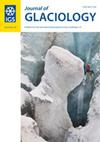The first cultivation of the glacier ice alga Ancylonema alaskanum (Zygnematophyceae, Streptophyta): differences in morphology and photophysiology of field vs laboratory strain cells
IF 2.6
3区 地球科学
Q2 GEOGRAPHY, PHYSICAL
引用次数: 3
Abstract
Abstract Melting glacier surfaces are unique ecosystems for specialized microbes, frequently harbouring blooms of microalgae with pigments contributing to the darkening of ice surfaces, reducing albedo and enhancing melt rates. The main cause of this phenomenon is algae of the genus Ancylonema. Prior investigation depended on field-collected material because these algae resisted cultivation. To enhance research on how these algae dominate melting ice, we established a strain of Ancylonema alaskanum from an alpine glacier and exposed to temperatures around the freezing point at irradiations of ~10% of full sunlight. The morphology of the culture changed, with the cells becoming longer and turning green by losing their brownish pigmentation, indicating that these dark phenols are crucial for survival in the cryosphere. Photophysiological comparisons of strain and glacial material showed adaptation of the photosynthetic apparatus to prevailing conditions. This laboratorial strain opens possibilities for a wide range of comparative ‘omics’ research.冰川冰藻alaskanum (zynematophyceae,链藻目)的首次培养:野外与实验室菌株细胞形态和光生理的差异
摘要融化的冰川表面是专门微生物的独特生态系统,经常含有大量微藻,这些微藻的色素会导致冰川表面变暗,降低反照率,提高融化速率。造成这种现象的主要原因是Ancylonema属的藻类。之前的调查依赖于现场收集的材料,因为这些藻类抗拒种植。为了加强对这些藻类如何主导融化的冰的研究,我们从高山冰川中建立了一株阿拉斯加Ancylonema菌株,并在约10%的全阳光照射下暴露在冰点附近的温度下。培养物的形态发生了变化,细胞变得更长,并因失去褐色色素而变绿,这表明这些深色酚类物质对在冰冻圈中的生存至关重要。菌株和冰川物质的光生理学比较表明,光合装置对主要条件的适应。这种实验室菌株为广泛的比较“组学”研究开辟了可能性。
本文章由计算机程序翻译,如有差异,请以英文原文为准。
求助全文
约1分钟内获得全文
求助全文
来源期刊

Journal of Glaciology
地学-地球科学综合
CiteScore
5.80
自引率
14.70%
发文量
101
审稿时长
6 months
期刊介绍:
Journal of Glaciology publishes original scientific articles and letters in any aspect of glaciology- the study of ice. Studies of natural, artificial, and extraterrestrial ice and snow, as well as interactions between ice, snow and the atmospheric, oceanic and subglacial environment are all eligible. They may be based on field work, remote sensing, laboratory investigations, theoretical analysis or numerical modelling, or may report on newly developed glaciological instruments. Subjects covered recently in the Journal have included palaeoclimatology and the chemistry of the atmosphere as revealed in ice cores; theoretical and applied physics and chemistry of ice; the dynamics of glaciers and ice sheets, and changes in their extent and mass under climatic forcing; glacier energy balances at all scales; glacial landforms, and glaciers as geomorphic agents; snow science in all its aspects; ice as a host for surface and subglacial ecosystems; sea ice, icebergs and lake ice; and avalanche dynamics and other glacial hazards to human activity. Studies of permafrost and of ice in the Earth’s atmosphere are also within the domain of the Journal, as are interdisciplinary applications to engineering, biological, and social sciences, and studies in the history of glaciology.
 求助内容:
求助内容: 应助结果提醒方式:
应助结果提醒方式:


